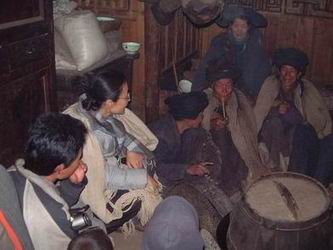史诗传统的田野研究

巴莫曲布嫫在美姑尔口村访问吉尼曲莫家支的老毕摩们
2003年9月9日下午,民族文学研究所彝族青年学者巴莫曲布嫫在本所“新世纪学术前沿十讲”的系列报告会上,以图文和音频的方式介绍了自己多年来的田野研究,“口头传统研究的普遍性意义在于探寻人类的表达文化之根。史诗传统的解读不同于书面诗歌的阐释之处,就在于它需要主体去主动建构一种动态的观察和全方位的研究,而建构即选择,也是某种程度的演绎和阐释,虽然田野研究也不可能不牺牲史诗传统本身的某种复杂性和丰富性。但这种基于田野观察的史诗演述描写和传统动态的研究,实则是为了更好地把握对象。一双脱离表演场域的眼睛是什么也看不见的,而一种缺乏对史诗传统进行实地观察的预期视野也就什么都发现不了,而仅仅就文本分析来做的史诗研究也就错失了许多揭示史诗传统的鲜活要素。”
巴莫曲布嫫于1998年考入北京师范大学中文系,师从钟敬文教授和董晓萍教授,攻读民俗学博士学位,研究方向是民间文艺学。2002年1月民俗学家、教育家钟敬文教授辞世后,由民间文艺学家刘魁立教授继续指导,于2003年 6月25日通过博士学位论文答辩,获法学博士学位。巴莫曲布嫫在师大学习期间,于1999年8月在芬兰土尔库大学参加了第五届世界民俗学者暑期国际培训,在“史诗工作小组”研修;1999年1月至2002年3月美国华盛顿大学与人类学教授Stevan Harrell(郝瑞)进行合作研究;2000年9月10日至2002年1月6在美国哈佛大学文理学院东亚语言与文明系作访问博士研究生,系统地学习了国外民俗学、文化人类学、宗教学等相关学科的理论,尤其是汲取了国外口头传统研究与史诗研究中诸多的方法论,学术视野开阔,理论功底深厚。
巴莫曲布嫫的学位论文《史诗传统的田野研究:以诺苏彝族史诗“勒俄”为个案》首先以优异的成绩通过了匿名评审,得到了5位国内专家的一致好评。答辩委员会由北京师范大学文学院5位博士导师组成,文艺学专家程正民教授任主席,委员有文艺理论专家童庆炳教授、民俗学教授刘铁梁、民俗学教授万建中、文艺学教授王一川。各位教授从多方面对这篇题为《史诗传统的田野研究:以诺苏彝族史诗“勒俄”为个案》的博士学位论文给予了充分肯定。刘铁梁教授认为,论文“复原了‘勒俄’实际文本的生存状态,为今后民族史诗研究作出了示范,标志着民族史诗研究正在发生深刻变化。”童庆炳教授认为:“彝族研究彝族史诗,投入了本民族的情感和对家乡民族文化、史诗的热爱,以学者的眼光来追溯史诗的原生态,透露出很好的理论素质和学术修养;用关注、吸收、保护、养育、兼收并蓄的态度来研究史诗,尊重传统,大胆挑战和质疑,带来了论文的学术特色,更表现了作者的开放性研究的胸怀和广阔的学术视野。”王一川教授认为,论文“选题难度大,拨乱反正,挑战性强,有创新意义,善于把学术探讨和族别认同结合在一起,充满了学理探讨和个人激情。”整个答辩过程是巴莫曲布嫫的研究成果的展示,也是一场充满知性智慧的学术交流。答辩委员会对巴莫曲布嫫的博士学位论文进行了如下评定:
“巴莫曲布嫫同学的博士学位论文,以彝族诺苏支系的史诗传统为个案,从民间叙事传统被“格式化”的问题反思中,实践了复归文本背后的史诗传统的田野技术路线,有助于推动学界重新检视以往的民俗学文本的制作方法。作者在运用民族语言学和语义学分析方法的同时,将国外民俗学、民族志诗学、文化研究等理论观照深入地投射到地方口头知识与本民族史诗话语的内部系统中,通过探讨口承传统与书写文化的交互关系,在民间口头论辩这一特定的民俗活动过程中,揭示并阐释了诺苏史诗传播─接受的文化生态,本土学者的“内部知识”优势和新一代史诗学者的理论思考得到了较好的统合。在此基础上,作者对本土社会的史诗演述人、史诗传承机制、史诗传统法则、史诗文本形态、史诗的叙事界域,史诗演述的仪式化叙事语境、史诗演述场域等问题,提出了一系列新的学术观点。论文从田野研究的具体案例中抽象出具有示范意义的研究模型和理论思考,对于深入阐解我国南方少数民族的史诗传统提供了一些学理性的参考与支持,标志着中国史诗研究正发生着深刻的变化,对史诗学、民间文艺学以及民俗学的田野研究也有一定的方法论意义。
该项课题主要涉及两种工作语言与大量的田野资料,在少数民族民间文艺学研究中实践了一种值得提倡的写作规范,从取样到引证一以贯之地依据国际上通行的学术标准。论文思路清晰,文字表述流畅,结论稳妥,多所创获。总之,这篇学位论文立足于本民族的民俗生活和史诗传统,严谨完成田野研究的学术实践,是一篇优秀的博士学位论文,对彝族史诗研究具有相当的推进作用。”
鉴于强调将史诗传统及其口头表演置于本土社会的仪式化叙事语境中去加以研究的重要性,该项田野研究在实际推进中,有如下几个彼此关联的重要环节:
1)通过一个地区──义诺彝区腹地美姑县──的史诗传承及其深隐的话语世界,2)通过一位传统中的史诗演述人──曲莫伊诺及其习毕学艺和表演实践,3)通过理解地方知识与民间话语中的史诗本体观念及其传统法则的深刻表达,4)通过“克智”口头论辩传统与史诗演述的内在机制、运作方式及特定的口头艺术过程,5)通过山地社会的仪式化叙事语境与史诗田野研究中的演述场域的确定,逐一讨论了史诗田野、史诗传承人、史诗传统法则、史诗演述的生命情态等互为关联的重要问题,并在此基础上,提出建立观察与捕捉口头叙事的本质性表现的研究视界──演述场域。这些有关史诗传统的学理性思考与相关术语的提炼,正是本文作为田野个案研究的意义所在。通过以上相互联系的五个步骤,基本实现了此项田野研究的工作目标,一是建立了一种系统的、有步骤的观察手段,二是在实际田野的表演情境中确立了具体的田野研究方式,并加以运用和调整,三是从表演个案的建立到个案的扩大,在对一位演述人的跟访过程中观察到了其他12位口头论辩能手(其中含7位史诗演述人)的表演活动,获得了大量的观察资料与实验性的分析数据。
关于“田野研究”,巴莫作了如下学理性的总结:
“田野”作为一种特定的学术空间为多个学科所共享,其方法论在积累了不少专门的经验之后,也在逐步的检讨过程中开始走向学理性的建构与抽绎。在国际民俗学的圈子里,以往多用fieldwork (田野作业),而近年来在参考平行学科或其支学(比如家乡人类学、文学人类学、民族志诗学等)方法论的同时,更多地吸纳民族志访谈、文化写作等相关的学术经验之后,民俗学者也渐渐地达成了某种共识。因此,我们可以看到的是,fieldwork(田野作业)已经逐步被并置到了field study(田野研究)之中。这一经并置,就为过往的田野作业法输入了某些新鲜而深刻的理念:
第一,田野研究在方法论的层面上含括着田野作业,并将之整合为田野研究中的基础环节,同时提倡个案与专题。对田野研究者而言,其案头准备工作和理论预设,就不仅包括了田野日程的计划和步骤、资料搜集的手段和技术、记录采访的专题和内容,以及进入社区的角色和方式等等具体操作层次与技术路线,还应当包括对田野问题的有效视界,田野关系的主动建立,地方知识体系的深刻理解,乃至田野笔记与田野访谈的规范化,田野中的跨文化经历与主动体验,田野写作中的文化发现等等更为丰富的理性思考。
第二,田野研究意味着田野中的研究,一俟田野开始,研究也就开始,并且随着田野的深入而同时得到推进,其工作方向是从桌面到田野,而非仅仅是从田野到桌面。这就要求我们要带着问题意识进入田野,同时还要在田野中发现问题,乃至问题的问题,并积极地就地分析问题和解决问题,而非仅仅针对业已设计完毕的“问卷”,或以“表格式”的预设框架为发现问题的禁锢。换言之,田野的目的不仅仅只是为了既定学术目标,或为了印证某种学术预设去调查、参与、观察和搜集资料。
第三,田野研究强调研究者主体在田野关系中对自身角色与功能的主动认知,对自身学术背景和“文化眼镜”可能形成的影像失真甚或倒置的敏锐体察,能够在研究主体与研究对象之间找到一种恰当的观察距离来切近对象,并适时地、主动地作出精细的调整。
第四,田野研究要求我们要从田野与文本两个维度来高度关注民俗学的“证据提供”(documentation),也就是说要从田野研究的一系列环节如,田野作业(fieldwork)、访谈(interview)、田野笔记(fieldnotes)、田野记录(transcribing)、田野报告(reporting)、田野?译(translating)、田野的文本化(textulizing)到最后形成一个系统的田野档案(archiving,包括田野文献识别、获取、处理、存储和传播等),才能最终支撑起被阐释的文本,而在史诗田野中,只有经过这一完整的、有步骤的、充满细节的田野研究流程,才能最终提供并支撑一种能够反映口头史诗传统本质的,以表演为中心的民俗学文本及其文本化制作流程。
第五,田野研究要自始至终地贯穿学术的思考、文化主题的发现和文化意义的揭示,最后都要落脚在理论概括的层面上。而任何形式的理论抽绎,都不过是从特定的角度入手、组织和梳理材料的结果。田野研究应该是一个走近对象到发现对象本质性规律的过程,而不是也不可能是一个穷尽研究对象的过程。因此,田野研究中对资料或文本的取舍和轻重,都深刻地浸透着研究者的“指纹”,也就是研究个性。
第六,在置身田野的过程中,理论和预想都要经受实践的检验。换句话说,在实地表演的场域中,对材料的透彻理解与语境关联的动态分析,会反过来对理论框架的搭建、分析模型的推演,乃至具体操作规程的调整产生深刻的影响。田野研究,一方面就意味着,它绝不仅仅是特定理论或学术预设的简单验证过程,而毋宁说是检验、修正,乃至颠覆预设理论的过程;另一方面,田野研究不是一种走向田野的姿态,而是一种学术主体能动性的激活装置,能够帮助我们去发现对象本质、去提炼出更切近对象、更符合对象本真,同时又能烛照其社会文化语境和史诗传统规定性的学理性阐释,因此,也为我们通过史诗田野的实际展开,而最终在史诗理论的思考中有所建树提供了更多的可能性。
作为一篇主要从民俗学角度研究史诗演述传统的论文,田野研究方法贯彻本文始终。从实际材料中生发理论,是论文的基本工作方向。“活鱼是要在水中看的。”巴莫总结道,“论文的努力,与其说是倡导一种工作方法,毋宁说是在田野研究的过程中通过体认与实践,经过曲折与矫正,渐次形成了一种较有系统的、具体的、能够更加接近史诗传统本真的田野研究路线。正是沿着这种工作方向,我们进入史诗田野,从鲜活的史诗演述中去探寻古老的民族叙事传统,而跟踪史诗演述人的田野过程,正是我们走近传统、发现传统,并揭示文本背后的史诗传统及其口头本质和生命力的工作流程。”
这次学术讲座得到了与会学者和研究生的好评,大家在讨论中认为,巴莫对“田野研究”进行了条分缕析的实证性演示,而“演述场域”及其“五个在场”要素的提出,不仅对史诗等民间口头叙事传统研究具有学理性的阐扬,也将对涉及田野工作的诸多人文学术有所启发。
(作者李列为北京师范大学文学院博士研究生)
作 者:巴莫曲布嫫
专 业:民俗学, 研究方向:民间文艺学;2003年6月获法学博士学位(民俗学)
导 师:钟敬文教授、刘魁立教授
在对涉及本课题的国内外学术史进行梳理和反思的过程中,结合田野研究中的史诗演述传统的实际存在,对史诗汉译本《勒俄特依》的文本转换及其工作流程提出质疑,从而概括出在这一过程中存在的“民间叙事传统格式化”问题及其对学术研究的影响,并在相关学术批评尺度的讨论中检讨“彝族史诗传统格式化”的种种弊端。由于“格式化”问题出现在中国民间文艺学发展中的特定历史阶段,并带有相当的普遍性,我们作出的探讨和解析,既针对史诗田野研究与口头叙事传统的文本转换问题,同时也希望引起整个民间文艺学界乃至民俗学界的关注。
以笔者多年的田野定点观察与追踪调查为线索,回溯笔者从文本走向传统的田野经历,以期说明史诗田野研究个案的基本思路及其形成过程,正是来自义诺彝区腹地的民俗文化传承,来自山地社会鲜活生动的史诗演述传统。而这些真切感受和学理性思考,则是逐步建立在笔者对山地仪式生活、史诗传统语域、社会话语空间等问题的索解过程之中的,进而也引领着论文作者在“自观”与“他观”的双重视野中,逐步走向田野研究的学术实践。
基于诺苏彝族史诗的传承轨范,我们将史诗传承人这一特定群体从概念上界定为“史诗演述人”。通过发现并跟访一位在口承传统与书写文化中成长起来的史诗传承人──曲莫伊诺,我们从家支文学传统、史诗传承机制、史诗演述人的“习毕”学艺经历与表演实践等层面,提出了若干学理性的思考,其中涉及到口头叙事的民间记忆与民间技艺,演述人的天赋、才艺和特殊的定向训练过程,史诗传承的“文化空间”与其内在规定性等问题。
从历时性的书写传承到现时性口头表演,逐步深入到史诗传统内部的运作机制中去解读民间的史诗话语与史诗观念,从以下几个层面进行文化义理的深掘,阐扬诺苏史诗传统的基本法则:第一,“勒俄”作为史诗传统并非是“一部作品”,其初始语义应还原为“口耳相传的族群叙事”,被诺苏彝人视为“历史的根谱”;第二,“勒俄十九枝”是史诗演述的叙事型构,堪称是诺苏史诗叙事“生命树”的主干与枝柯,前有“勒俄述源”作为叙事的开端,后有“布茨叙谱”作为叙事的连续性实现,由此构造了史诗演述的基本叙事框架;第三,从“万物雌雄观”与史诗叙事的文化象征体系,阐释了“勒俄”文本的公/母之别,并将之界定为史诗的文本性属与文本界限;第四,从文化传统与社会心理解析了史诗叙事的黑/白之分,由此框定了史诗的叙事界域――这是由仪式语境与传统语域所制导的;第五,从史诗抄本的版本系统和传播路线,探讨了史诗异文的界定原则。诺苏史诗传统的基本法则的发现、归纳和总结,当是我们田野研究的重要成果之一。
首先,从口头论辩过程中互为关联的两个阶段(路下方和路上方)入手,揭示了即兴辞辩与史诗演述之间的密切联系,说明民间的史诗演述与口头论辩活动始终是融为一体的;其次,强调了史诗叙事的原典性原则;该原则虽然总结自特定传统,但具有相当的通约性,能够指涉民间表演的普遍问题。再者,原典性原则很好地说明了史诗异文的研究方法和目的。最后,认定“克智”论辩的兴起和传承,在客观上激活了史诗演述的口头传播和动态接受,使史诗传承人脱离了各种文本的制约而走向面对面的社群,并在特定的竞争机制中不断提高自己承继传统的口头创编能力与表演艺术,从而促进了史诗传统的长期流布和动态发展。
以史诗演述的仪式化叙事语境为出发点,提炼出“演述场域”这一重要的田野研究视界,论证了田野观察中不可或缺的“五个在场”要素。演述场域的拟构,具有确立田野研究新范式的意义,它涉及研究传统文化的基本学术取态和研究者的主体能动性,涉及从田野到文本的学术转换和学术表述等环节。“演述场域”的理论性总结,不仅是方法论问题,而且也是知识论问题,期望它能有助于廓清学界在田野─文本之间产生的一些模糊认识。
关键词:
诺苏彝族 史诗“勒俄” 田野研究 史诗传统法则 口头论辩 史诗演述 演述场域
Nuosu epic hnewo-epic traditional law-living oral performance-verbal arts- epistemological approach



 / Recommendation
/ Recommendation

 / Reading list
/ Reading list